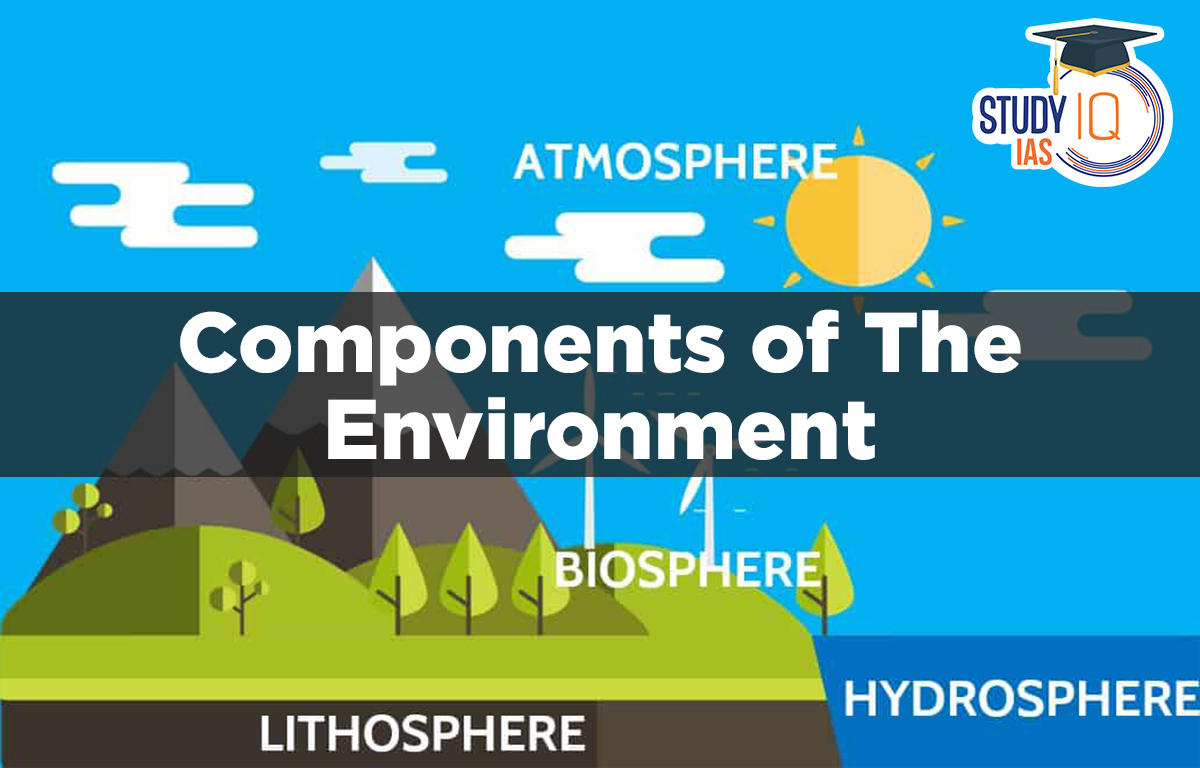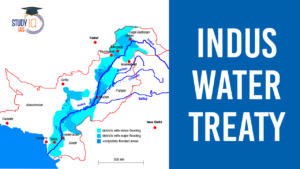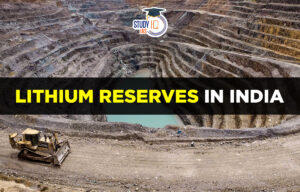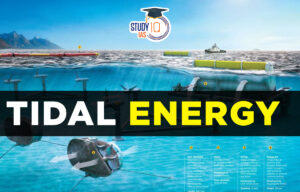Table of Contents
Components of Environment
Everything in our immediate surrounds, including both living and nonliving things like soil, water, creatures, and plants that adapt to their conditions, is referred to as the “environment.” It is a gift from nature that helps to sustain life on Earth. The survival of life on Earth depends on the environment. A biosphere component that affects the condition of the entire planet is an ecosystem. It includes both live and inanimate objects in the environment. The elements that make up the environment can be broadly separated into two groups:
- Biotic Components
- Abiotic Components
Major Components of Environment
The environment consists of two major components: biotic and abiotic. The biotic components are all living things, while the abiotic components are all nonliving things.
Biological Component
The biological component of the environment, as the name suggests, consists of all living organisms. As a result, it is frequently referred to as the biotic component of the ecosystem. Animals, plants, and microorganisms interact with abiotic elements to build ecosystems. Additionally, several types of organisms, including producers, consumers, and decomposers, are separated apart in these ecosystems.
Physical Component
The physical component of the environment is the non-living portion. Abiotic factors, which include things like air, water, soil, and climate, are also referred to as them. The three major categories of physical elements are the atmosphere, the hydrosphere, and the lithosphere. Scientists frequently refer to the zone of life as the “biosphere” (or the worldwide sum of ecosystems).
Major Components of Environment
The three main elements of the environment are the lithosphere, atmosphere, and hydrosphere. The lithosphere is the term for the solid portion of the earth. The Earth is surrounded by gaseous layers that make up the atmosphere. The atmosphere is composed of gases including oxygen, nitrogen, carbon dioxide, and others. The vast volume of water that makes up the majority of the earth’s surface is known as the hydrosphere. This water is present as liquid, ice, and water vapour.
- Lithosphere: The crust, the earth’s topmost layer, is composed of several minerals. It can be found on both land (terrestrial crust) and the oceans, where its depth can reach up to 100 kilometres (oceanic crust). Tectonic plates on Earth are the primary part of the lithosphere.
- Hydrosphere: It includes all types of water bodies found on Earth, such as oceans, seas, rivers, lakes, ponds, and streams, among others. On Earth, it covers 70% of the surface. The oceans contain salt water, which makes up 97.5% of the total amount of water on Earth. Freshwater makes up only 2.5% of the world’s water. Out of this, 68.9% is frozen in glaciers and 30.8% is accessible as groundwater. Rivers, reservoirs, and lakes have a quantity of 0.3% that is readily available to humans.
- Atmosphere: It is a gaseous layer that surrounds the planet. The amount of oxygen in Earth’s atmosphere is unique and necessary for life. In addition to traces of hydrogen, helium, and noble gases, it is mostly composed of 78.08% nitrogen, 20.95% oxygen, 0.93% argon, and 0.038% carbon dioxide. Variable amounts of water vapour are present.
- Biosphere: It describes all areas of the planet where life is present. Ecosystems that support life may exist in the soil, the air, the water, or the land. Geologist Edward Suess came up with the word “biosphere” to describe the area of the planet where life can be found. A biosphere is the whole of all living things, often known as biomass or biota. It stretches from the arctic ice caps to the equator, with some type of life existing in each area that is appropriate for the environment there.
| Environmental Element | Description |
|---|---|
| Lithosphere | The solid portion of the Earth’s crust is composed of various minerals; includes both terrestrial and oceanic crust; depth of oceanic crust can reach up to 100 kilometres; features tectonic plates. |
| Hydrosphere | Encompasses all water bodies on Earth, such as oceans, seas, rivers, lakes, ponds, and streams; covers 70% of Earth’s surface; oceans contain 97.5% saltwater, while freshwater constitutes 2.5%, with 68.9% frozen in glaciers, 30.8% as groundwater, and 0.3% readily accessible. |
| Atmosphere | The gaseous layer surrounding the planet; is primarily composed of nitrogen (78.08%) and oxygen (20.95%), with traces of argon, carbon dioxide, water vapour, and other gases. |
| Biosphere | The area of the planet where life exists, including ecosystems found in soil, air, water, and land; stretches from polar regions to the equator, supporting various forms of life adapted to their environments. |
Biotic Components of Environment
The ecosystem’s biotic elements are the living things that make up the ecosystem. Examples of biotic factors include fungi, bacteria, animals, plants, and animals. Based on the source of energy, these biotic components can be further divided into producers, consumers, and decomposers.
- Producers: These comprise every autotroph. They produce food on their own using light energy, such as plants, green algae, and other organisms.
- Consumers: All heterotrophs that rely on producers for food, whether directly or indirectly, fall under this category. Herbivores, carnivores, omnivores, and parasites are additional categories for consumers.
- Decomposers: These include saprophytes, which use dead materials and their decay as food.
When they begin interacting with one another, biotic and abiotic elements of an ecosystem become relevant. For instance, biotic components like plants serve as food for other living things. The soil is an abiotic component that supports plant growth by supplying nutrients and other necessary ingredients. Abiotic variables like soil, nutrients, and other abiotic components are created by and dependent on biotic components.
Biotic Components of Different Ecosystems
- Biotic Components of Terrestrial Ecosystem: Plants, Fungi and Bacteria
- Biotic Components of Desert Ecosystem: Plants (Drought-tolerant plants), Desert Animals, Birds, Reptiles and Amphibians, Insects
Abiotic Components of Environment
Abiotic factors are defined as chemical or physical elements that have an impact on living things as a result of their existence or way of life. They go by the name “ecological factors” as well. The environment, light, air, soil, nutrients, and other physical and chemical factors make up the abiotic component of an ecosystem.
Abiotic ecosystem elements generally vary from one ecosystem to the next. Abiotic components like salinity, e-water death, readily available nutrients, and dissolved oxygen are present in the aquatic ecosystem. The type of soil, rain, wind, temperature, altitude, sunlight, and nutrients are all significant factors in terrestrial ecosystems. The two main categories are climate and edaphic influences.
Categories of Abiotic Components
- Edaphic Factors: The minerals, soil profile, soil organic matter, soil moisture, and different types of soil are all edaphic components connected to the composition and structure of the soil.
- Climatic Factors: Climate elements are the physical and climatic aspects of the environment, including air temperature, wind, humidity, and water.
Examples of Abiotic Components
- Water
- Light
- Temperature
- Humidity
- Soil
- Topographic Factor
Impact on Abiotic Components
Like other organisms, humans need on particular abiotic circumstances to survive and flourish. Abiotic factors can vary as ecosystems evolve. Some ocean basins’ acidity has gone up by 30% since the Industrial Revolution. Due to their inability to adapt to the rising acidity, coral reefs suffer.
Other organisms, such as marine snails, who lose their protective shells in acidic environments, suffer injury as well. Abiotic factors change whenever, for instance, an air conditioner is turned on or salt is applied to a road to help snow melt. Over time, these effects will disrupt the ecology as a whole.
Biotic Components Vs Abiotic Components
| Factors | Biotic Components | Abiotic Components |
| Definition | In an ecosystem, there are living things called “biotic factors.” | Abiotic factors are all non-living elements, such as physical circumstances and chemical elements that have an impact on an ecosystem. |
| Example | Biotic resources comprise all forms of vegetation and wildlife. | Sunlight, water, air, humidity, pH, temperature, salinity, precipitation, altitude, type of soil, minerals, wind, dissolved oxygen, mineral nutrients present in the soil, air, and water, among others, are examples of abiotic variables. |
| Dependence | Abiotic factors are necessary for the survival and reproduction of biotic factors. | Abiotic factors stand entirely apart from biotic factors. |
| Origin | The biosphere provides the basis for biotic components. | The lithosphere, hydrosphere, and atmosphere are the sources of abiotic components. |


 Indus Water Treaty, Historical Context, ...
Indus Water Treaty, Historical Context, ...
 Lithium Triangle, Lithium Reserves in In...
Lithium Triangle, Lithium Reserves in In...
 Tidal Energy in India, Diagram, Advantag...
Tidal Energy in India, Diagram, Advantag...


















